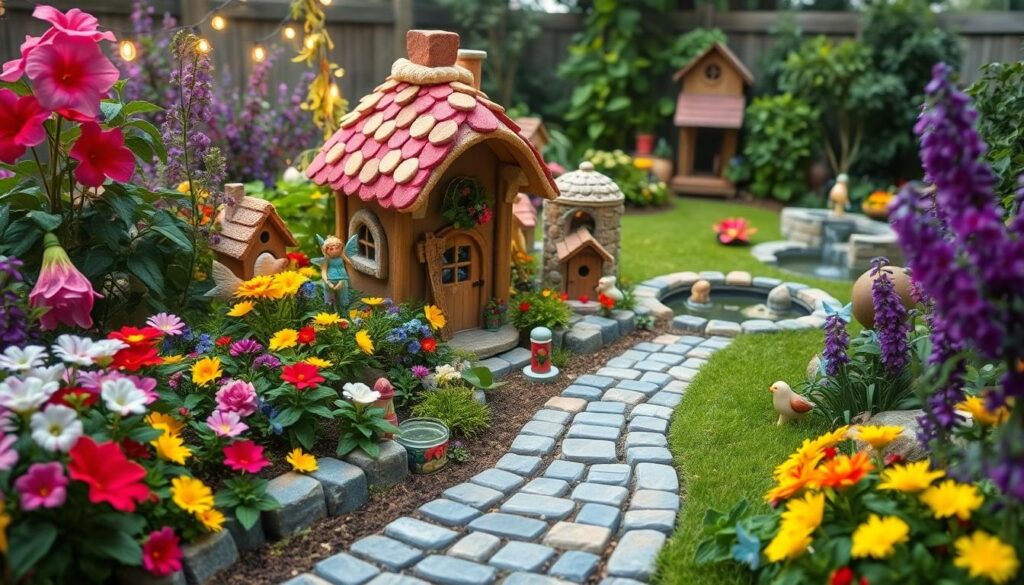Creating a fairy garden is a magical way to bring enchantment to any space, whether it’s your backyard, patio, or even a small indoor corner. These miniature wonderlands capture the imagination and transport us to a industry where tiny mystical beings might actually exist. We’ve gathered some of the most delightful fairy garden ideas to inspire your next crafting adventure.
We’ll explore everything from woodland-themed fairy gardens with moss-covered pathways to beach-inspired designs complete with miniature seashell chairs. With just a few simple materials and a touch of creativity, you can create a whimsical retreat that’ll charm both children and adults alike. Ready to discover how to create your own pocket-sized magical area? Let’s jump into these captivating fairy garden ideas that’ll transform any ordinary space into something extraordinary.
10 Enchanting Fairy Garden Ideas to Transform Your Outdoor Space
1. Miniature Cottage Retreat
Creating a charming cottage centerpiece gives your fairy garden a focal point that draws the eye. We recommend using small birdhouses or decorative wooden structures that can be painted with weatherproof paint in whimsical colors. Add tiny windows with curtains made from scraps of fabric, and create a small stone pathway leading to the front door. Surrounding your cottage with miniature flowering plants like creeping thyme or baby’s tears creates a lush, lived-in look that fairies would love to call home.
2. Woodland Wonderland
Transform a shady corner into an enchanted forest with miniature trees, toadstools, and moss-covered stones. Pine cones can serve as perfect fairy-sized trees when positioned upright in soil. Small potted ferns and ivy create the perfect canopy for shy woodland fairies. Arrange flat stones in a circular pattern to create a fairy meeting place, and add tiny acorn cap bowls or hollowed-out pebbles as fairy dining tables.
3. Teacup Fairy Garden
Repurpose broken or chipped teacups and saucers into delightful fairy homes with minimal effort. Fill the teacup with soil and plant small succulents or moss as the base greenery. Tiny pebble pathways can wind around the plants, leading to a small fairy door attached to the side of the cup. Teaspoons inserted handle-first into the soil become charming fairy slides when positioned at an angle.
4. Fairy Tree Stump Village
Old tree stumps offer the perfect foundation for a multi-level fairy community. Hollow sections become natural fairy apartments while the flat top surface transforms into a garden or meeting area. Carve small windows and doors into the sides of the stump, or attach premade fairy doors available at create stores. Planting moss and small ferns around the base softens the look and creates a more established feeling for your fairy village.
5. Fairy Garden Water Feature
Adding a miniature water feature creates a magical focal point that captures light and attracts beneficial wildlife. Small shallow dishes or pot saucers work perfectly as fairy-sized ponds. Line them with blue glass stones for a water effect, or use actual water with tiny floating plants like duckweed. Placing small polished stones around the edges creates a natural-looking shoreline, while tiny bridges made from twigs allow fairies to cross from one side to another.
6. Beach-Themed Fairy Garden
Create a coastal retreat using a shallow container filled with fine sand. Incorporate small seashells, beach glass, and pebbles to create pathways and decorative elements. Miniature beach chairs made from popsicle sticks and fabric scraps provide resting spots for sun-loving fairies. Small driftwood pieces become perfect fairy-sized surfboards or boats, while blue glass stones arranged in a corner create the illusion of ocean waves.
7. Seasonal Fairy Garden
Design a garden that changes with the seasons to keep your fairy industry fresh and captivating year-round. Spring containers might feature miniature flowering bulbs and pastel decorations, while summer gardens showcase tiny vegetable plots and swimming areas. Fall fairy gardens can include miniature pumpkins and colorful leaf pathways, with winter displays featuring evergreen plants and tiny Christmas decorations that create a festive fairy wonderland.
8. Vertical Fairy Garden
Maximize limited space by creating a vertical fairy garden using tiered planters or repurposed items like old ladders or wall-mounted containers. Each level becomes a different fairy neighborhood connected by twisting vine stairs or pebble pathways. Installing small solar-powered fairy lights brings the vertical garden to life at night, creating a magical glowing tower that adds dimension and height to your outdoor space.
9. Fairy Garden Terrarium
Glass containers provide protected environments for indoor fairy gardens that thrive year-round regardless of outdoor conditions. Layer activated charcoal at the bottom for drainage, followed by potting soil and living moss as the base. Adding air plants or miniature ferns creates varied textures without requiring much maintenance. Small figurines and fairy houses nestled among the greenery create magical scenes visible from all angles through the clear glass walls.
10. Upcycled Container Fairy Garden
Transform everyday items into unique fairy garden containers that add personality and charm. Old wagons, wheelbarrows, toolboxes, or even worn-out boots make perfect unusual homes for fairy communities. The container itself becomes part of the story—a wooden drawer might become an elegant fairy apartment building, while a vintage watering can transforms into a fairy water park. Planting cascading flowers around the edges softens the look while hiding container edges for a more natural appearance.
Creating a Miniature Fairy Garden in a Flower Pot
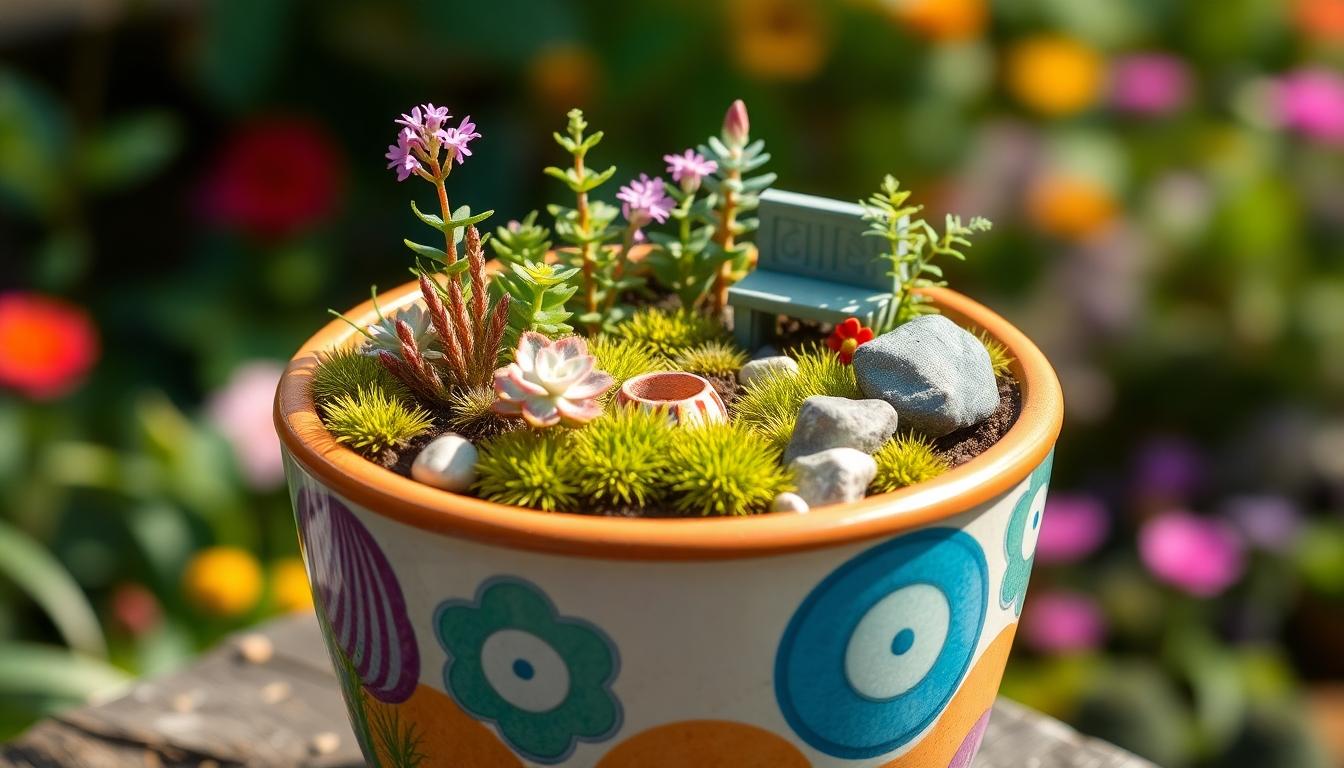
Miniature fairy gardens in flower pots offer a perfect blend of whimsy and practicality, creating magical worlds in compact spaces. We’ve compiled a simple step-by-step guide to help you create your own enchanting container garden that will delight visitors of all ages.
- Choose a Container: Select a flower pot that provides adequate depth for soil and plant roots. Many successful fairy gardens use broken pots to create interesting multi-level landscapes with natural terraces.
- Prepare the Soil: Fill your chosen container with quality well-draining potting soil. For gardens with multiple levels, try mixing clay-rich dirt with water to create sturdy supports or miniature staircases.
- Add Plants: Incorporate small-scale greenery like moss, sedum, and portulaca that require minimal space and maintenance while creating a lush backdrop for your fairy inhabitants.
- Decorate with Miniatures: Create pathways using tiny rocks, sand, or fine gravel. Enhance the magical atmosphere by adding miniature furniture, colorful shells, or decorative stones as accent pieces.
Selecting the Perfect Container for Your Fairy Garden
The container you select serves as the foundation for your entire fairy garden network. Clay, ceramic, and wooden pots offer a natural aesthetic that complements the whimsical theme of fairy gardens. Ensure your chosen container provides sufficient depth to accommodate plant roots and proper drainage to prevent waterlogging.
Creative gardeners often repurpose broken flower pots to design multi-layered fairy landscapes. These fractured containers create natural divisions that can represent different “rooms” or areas within your miniature industry. The irregular shapes and levels add visual interest while providing varied planting zones for different types of greenery.
Essential Fairy Garden Plants for Container Gardens
The right plant selection brings your fairy garden to life with appropriate scale and texture. Moss creates a perfect miniature carpet effect, establishing a lush green foundation for your magical industry. Varieties of sedum and portulaca thrive in container environments while requiring minimal maintenance, making them ideal choices for busy gardeners.
Miniature herbs such as thyme or chamomile introduce wonderful fragrance while maintaining the proper scale for your tiny garden. English daisies add charming floral elements that enhance the whimsical atmosphere of your fairy domain. These plant combinations create a living backdrop that evolves and grows alongside your fairy garden accessories, keeping your creation fresh and captivating throughout the seasons.
Building a Whimsical Fairy Tree House
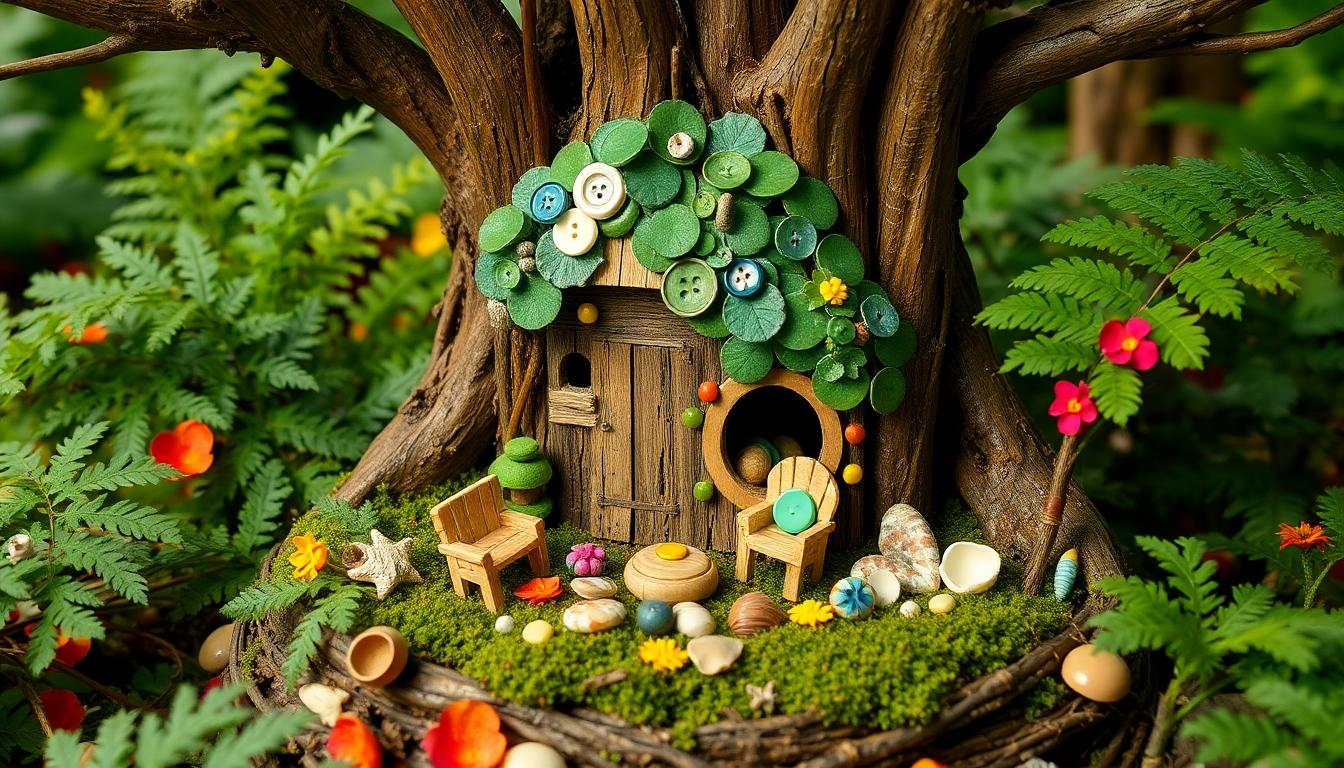
Creating a fairy tree house is perhaps the most enchanting element of any fairy garden, serving as the centerpiece that brings your miniature industry to life. These tiny arboreal dwellings capture the imagination and establish the magical mood of your garden.
Using Natural Materials for an Authentic Look
Natural materials form the foundation of truly captivating fairy tree houses. Bark pieces create rustic walls, while twigs and small branches serve as perfect structural elements for your miniature dwelling. Moss offers an ideal roofing material, adding a lush, verdant touch that blends seamlessly with the surrounding garden. Positioning these charming creations under low-hanging branches or nestled among ferns enhances their hidden, magical quality.
Birdhouses can provide excellent ready-made foundations that you can transform with natural embellishments. Acorn caps make delightful tiny dishes or decorative elements, while flower petals add splashes of color throughout your fairy habitat. Incorporating seashells, pebbles, and dried grasses helps mimic natural environments and grounds your creation in an earthy aesthetic.
Terra cotta pots filled with soil and appropriately scaled plants create a cohesive base for your fairy tree house scene. Remember to protect any cardboard-based structures by either covering them or moving them indoors during rainy weather to preserve your magical creation.
Incorporating Tiny Furniture and Accessories
Miniature furniture transforms a simple structure into a livable fairy dwelling. Create charming chairs from Popsicle sticks, create adorable flip-flops from buttons, or fashion miniature towels from small pieces of terry cloth. These personalized touches bring authenticity and character to your fairy tree house.
Connect multiple levels of your fairy garden using rustic bridges or ladders made from twigs and string. This approach works especially well when linking tiered planters, creating a multi-dimensional fairy community. For those seeking quick answers, prefabricated fairy cottages and figurines offer convenience while maintaining charm.
Wooden beads can simulate beach balls for a playful touch, while Popsicle sticks make excellent fencing to define different areas of your fairy property. The combination of store-bought accessories with handmade elements results in a uniquely personal fairy tree house that reflects your creative vision while maintaining an organic, woodland feel.
Designing a Magical Fairy Garden Pathway

After creating your enchanting fairy houses and miniature gardens, pathways serve as the perfect connecting elements that bring your fairy garden to life. Thoughtfully designed paths not only guide visitors through your magical industry but also add structure and whimsy to your creation.
Material Options for Fairy Pathways
Cobblestone paths create an old-industry charm that’s perfect for traditional fairy gardens. Flagstone offers a more natural, woodland feel that blends seamlessly with surrounding plants. Moss pathways provide a soft, lush green carpet that evokes a sense of enchantment and ancient forest magic. Tree stump slices can be arranged in a winding pattern to create a more whimsical stepping-stone effect that appears as if the fairies themselves carved them from the forest floor. Winding paths rather than straight ones enhance the mysterious feel, inviting exploration of your miniature industry while making the space appear larger than it actually is.
Themed Pathway Elements
Fairy-themed furniture positioned along your pathways creates rest spots where your miniature inhabitants can gather. Tiny benches, tables, and chairs placed strategically at pathway intersections establish charming vignettes that tell a story. Miniature gardens flanking the paths add depth and interest, with small-scale plants like thyme or baby tears creating perfect boundaries. Themed decorations such as miniature lampposts, signposts, or mailboxes transform simple paths into narrative elements that enhance the immersive experience of your fairy garden. Garden ornaments like tiny wheelbarrows, buckets, or garden tools suggest that the fairies are actively tending to their magical area.
Creating Stepping Stones with Natural Materials
River rocks offer smooth, naturally rounded surfaces ideal for creating durable stepping stones in your fairy garden. Flat stones collected from nature provide authentic-looking paths that blend perfectly with the garden environment. Wooden slices cut from branches create rustic stepping stones with natural wood grain patterns that weather beautifully over time. Customizing your stepping stones with acrylic paint allows you to add colorful designs, fairy symbols, or even tiny welcome messages for your miniature garden visitors. Mosaic pieces pressed into clay or concrete stepping stones create colorful, sparkling pathways that catch the light beautifully.
Adding Twinkling Lights to Illuminate the Path
Solar-powered string lights work wonderfully for fairy gardens, charging during the day and automatically illuminating pathways at dusk without requiring electrical connections. Fairy lights with their delicate, tiny bulbs create a magical starlight effect when woven among plants or along pathway edges. Miniature lanterns placed at intervals along your paths suggest that fairies light their way home after twilight adventures in your garden. Strategic light placement helps highlight special features in your fairy garden, such as a tiny waterfall, fairy doors, or intricate miniature sculptures. Soft illumination creates dramatic shadows and a magical twilight effect that transforms your daytime fairy garden into an enchanted nighttime wonderland.
Crafting a Fairy Garden Water Feature
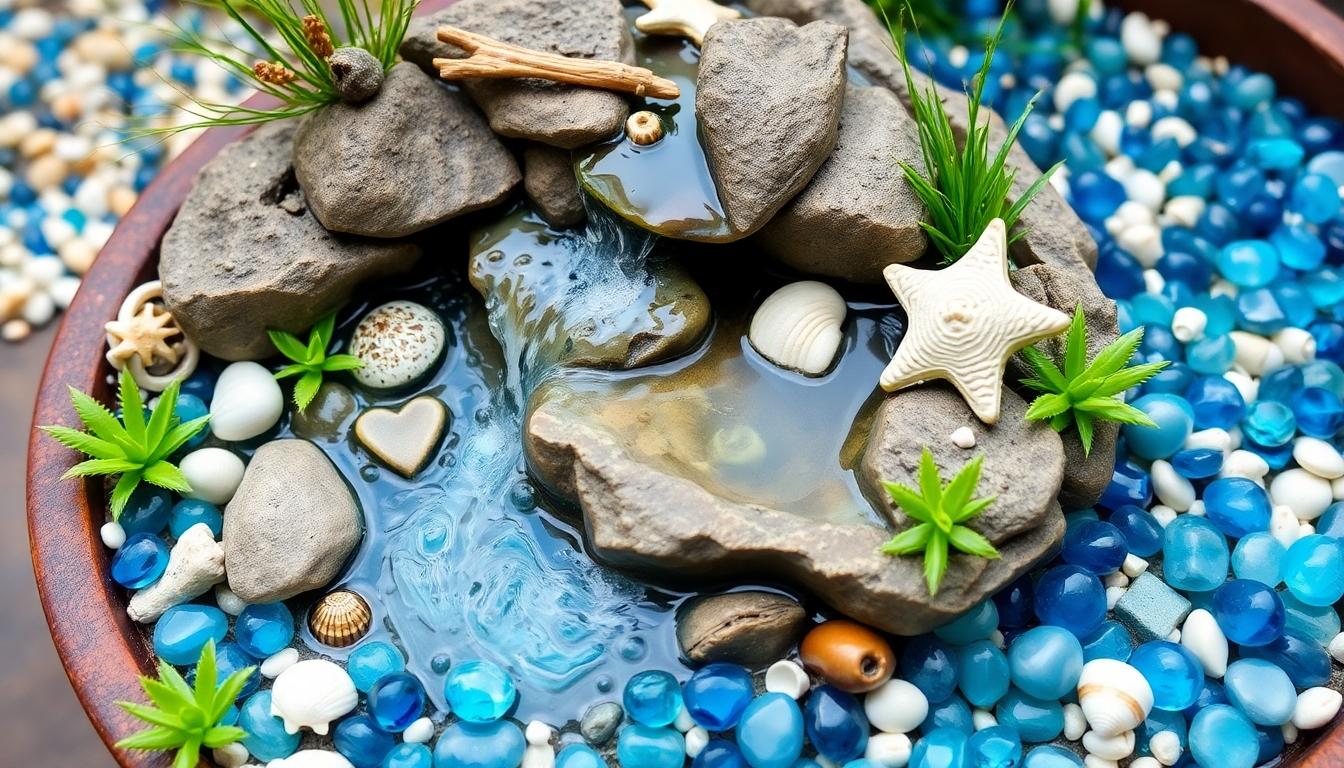
Water features add a magical dimension to fairy gardens, creating movement, sound, and reflection that bring these miniature worlds to life. Introducing water elements transforms an ordinary fairy garden into an enchanting oasis that captivates visitors of all ages.
Miniature Ponds and Waterfalls
Creating miniature ponds and waterfalls requires thoughtful planning but delivers stunning results. Select a durable, watertight container such as a large bowl or small birdbath as your base for a reliable water feature. Small pumps provide essential water circulation, creating a delightful waterfall effect as water flows from higher to lower levels. Position low-growing plants that thrive in moist environments around your water feature, with mosses and small aquatic varieties working particularly well in these settings. The gentle sound of flowing water adds a sensory dimension to your fairy garden that static elements cannot achieve.
Beach-Themed Fairy Gardens with Blue Glass Pebbles
Transform your fairy garden into a coastal retreat using blue glass pebbles that perfectly mimic the shimmer of ocean waters. These vibrant blue elements create an eye-catching focal point when paired with sandy-colored decorative stones for an authentic beach appearance. Add miniature beach accessories such as tiny seashells, driftwood pieces, or diminutive beach chairs to enhance the seaside atmosphere. Select plants with distinct coastal characteristics, like succulents resembling sea anemones or small shrubs that mimic beach grasses, to complete the maritime theme. A small fountain nestled among the blue pebbles can simulate ocean waves, adding both visual interest and soothing sounds to your beach-themed fairy garden.
Incorporating Seasonal Themes in Your Fairy Garden
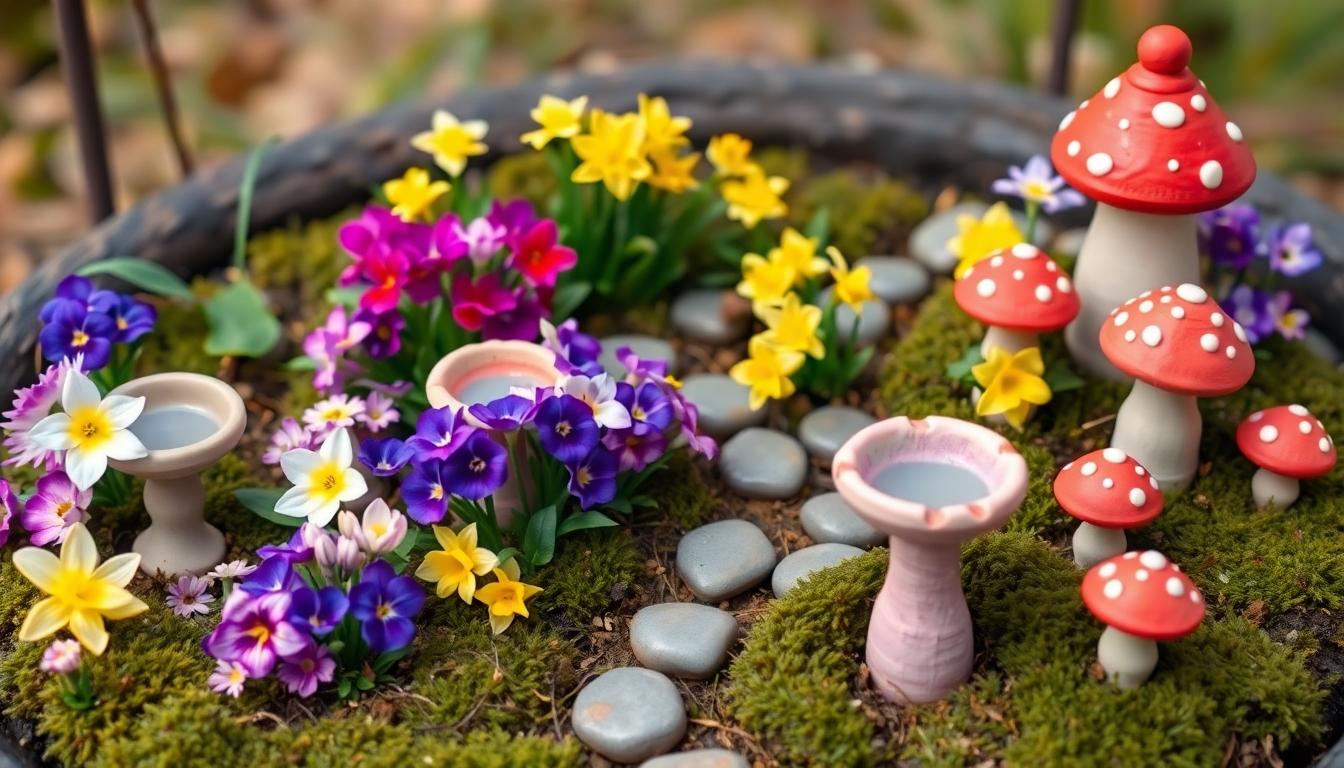
Seasonal fairy gardens transform with the changing weather and holidays, keeping your miniature industry fresh and exciting year-round. We can easily adapt our fairy gardens to reflect nature’s cycles by swapping plants and accessories to match each season.
Spring Fairy Garden Ideas with Blooming Flowers
Spring fairy gardens burst with new life through vibrant blooming flowers like pansies, primroses, and dwarf daffodils. Adding miniature birdbaths or handcrafted polymer clay mushrooms creates charming focal points among the spring blossoms. Terracotta pots filled with trailing plants offer vertical interest, while wicker baskets containing spring bulbs nestled in moss create natural-looking displays. Mason jar gardens decorated with decoupaged floral designs provide portable spring fairy habitats that can brighten any indoor space. Create moss-lined pathways between flowering plants to guide your fairy visitors through their rejuvenated spring home.
Winter Wonderland Fairy Gardens
Winter fairy gardens showcase evergreen plants such as dwarf conifers that maintain their beauty during colder months. Faux snow made from cotton or glitter transforms the industry into a frosty fairyland. Miniature lanterns cast a warm glow against the winter backdrop, while ice-resin accessories sparkle like real icicles in the light. Stone cottages with “snow-covered” bark roofs provide cozy shelter for winter fairies. Clear beads or blue glass pieces cleverly repurposed as frozen ponds add a magical frozen water feature to your winter wonderland. Campsite-themed elements complete with tiny campfires and faux fur blankets introduce an inviting touch of warmth and comfort to your chilly fairy setting.
Upcycling Household Items for Fairy Garden Structures
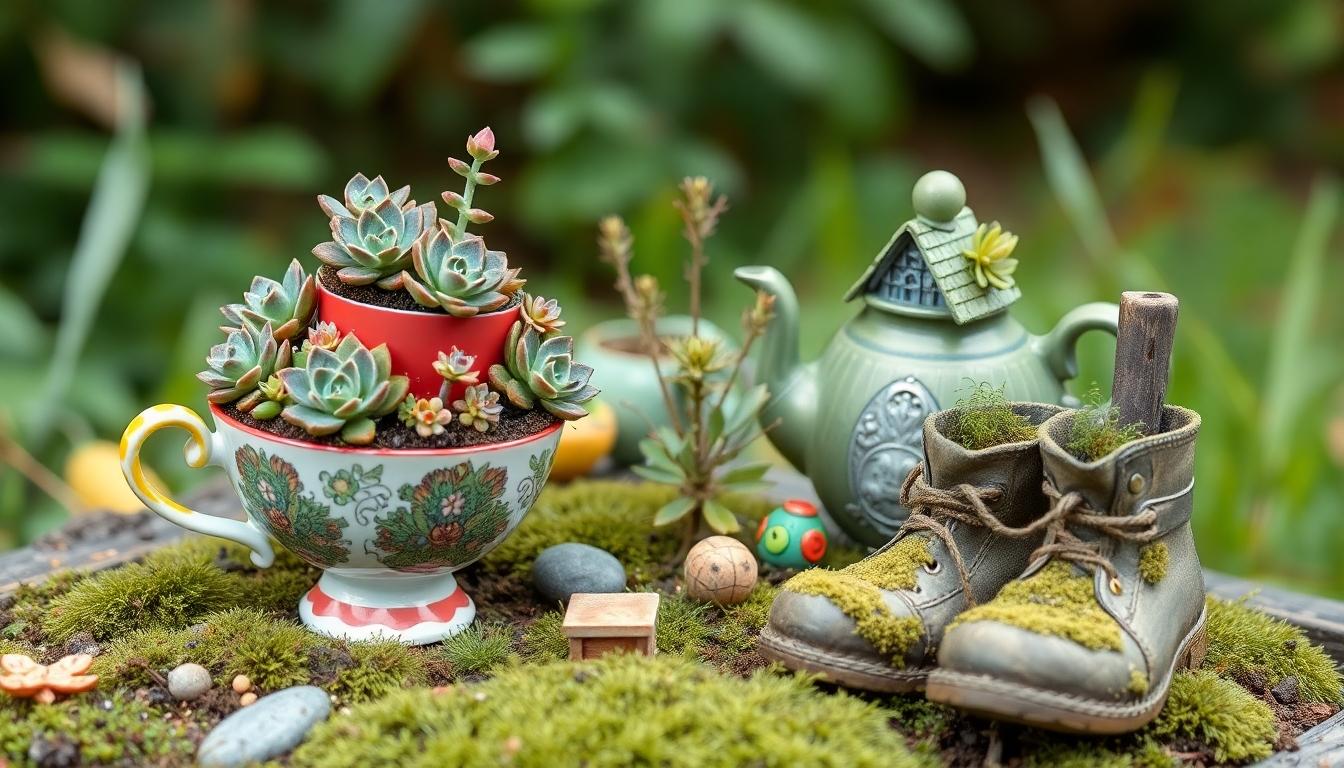
Transforming everyday household items into charming fairy garden structures adds personality while reducing waste. Recycled materials like plastic bottles, aluminum cans, and food containers easily become whimsical elements in your miniature industry.
Repurposing Teacups and Teapots
Chipped or mismatched teacups make perfect tiny planters for succulents or moss beds in your fairy garden. Their elegant curves and decorative patterns create instant character without additional crafting. We recommend lining the bottom with small pebbles for drainage before adding soil to ensure your miniature plants thrive. Teapots serve as stunning focal points when positioned as fairy houses, with the spout covered in moss to create a natural roofline. Creating pathways from tiny pebbles leading to a teapot door transforms an ordinary item into an extraordinary fairy dwelling. These repurposed tea items offer the perfect blend of vintage charm and practicality for indoor fairy gardens.
Transforming Old Boots and Wheelbarrows
Old garden boots provide ideal contained spaces for creating miniature landscapes with personality and depth. Line worn-out boots with moss before adding soil and small plants to create a rustic fairy garden with built-in character. Wheelbarrows, whether miniature decorative versions or old broken ones, offer excellent platforms for creating more elaborate fairy garden displays. Fill these garden favorites with layers of soil, moss, and miniature accessories like polymer clay furniture to create a multi-dimensional fairy industry. Positioning tiny fairy doors against the sides of wheelbarrows creates the illusion of hidden homes within your garden feature. Weather-resistant materials work best for these outdoor displays, ensuring your upcycled fairy gardens withstand the elements while continuing to delight visitors throughout the seasons.
Choosing the Perfect Fairy Figurines and Accessories

Selecting the right fairy figurines and accessories elevates your fairy garden from ordinary to extraordinary. These miniature elements breathe life into your tiny industry, creating a industry of whimsy and wonder. When choosing decorative pieces, look for items that complement your garden’s theme and color palette for a cohesive, enchanting atmosphere.
Handmade vs. Store-Bought Fairy Garden Elements
Handmade fairy garden elements offer unmatched personalization and creative expression. These custom creations reflect your unique style and vision, making your fairy garden truly one-of-a-kind. Crafting your own accessories allows for perfect size and color coordination with your exact garden design. Try making charming chairs from Popsicle sticks, delightful beach balls from wooden beads, or adorable flip-flops from colorful buttons for a personalized touch. The main drawback to DIY elements is the time investment required, and homemade items might not withstand outdoor conditions as well as commercially produced alternatives.
Store-bought fairy garden elements provide convenience and durability for busy gardeners. These ready-made accessories save valuable time and typically feature weather-resistant materials designed for longevity. Retailers like Home Depot offer comprehensive fairy garden kits containing everything needed to create a magical miniature industry. The primary disadvantage of pre-made items is their lack of uniqueness, as many gardeners may have identical pieces in their displays. Combining both handmade and store-bought elements often creates the most satisfying fairy garden experience, balancing personalization with practicality.
Weather-Resistant Materials for Outdoor Fairy Gardens
Outdoor fairy gardens require durable materials that can withstand changing weather conditions throughout the seasons. Ceramic, glass, and metal accessories resist fading and deterioration when exposed to rain, sun, and temperature fluctuations. These weather-hardy materials maintain their charm year after year without frequent replacement.
Plant selection plays a crucial role in outdoor fairy garden longevity. Succulents and hardy annuals thrive in various conditions, providing reliable greenery regardless of climate challenges. These resilient plants create a consistently lush backdrop for your fairy scenes while requiring minimal maintenance.
Creating sturdy pathways ensures your fairy garden remains accessible and attractive even though outdoor elements. Flat rocks and small pavers make excellent stepping stones that withstand rain and provide stable footing for your fairy residents. Natural stone elements blend seamlessly with the garden environment while offering exceptional durability against moisture and temperature changes. Incorporating these weather-resistant materials ensures your outdoor fairy garden remains a magical retreat through every season.
Creating a Fairy Garden with Children
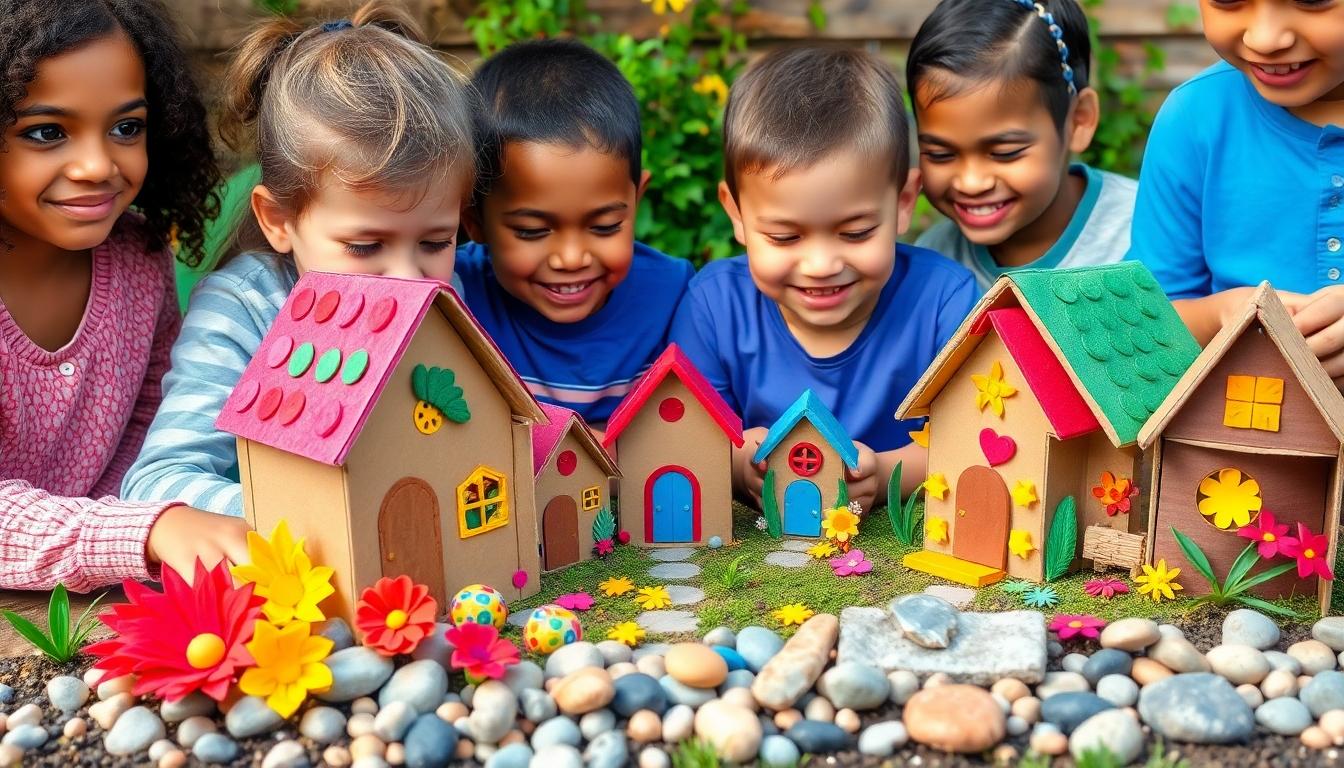
Building fairy gardens with children offers a magical way to spark creativity while spending quality time together. We’ve found that using accessible materials makes this activity both fun and educational for kids of all ages.
Age-Appropriate Fairy Garden Projects
Toddlers and preschoolers thrive with simple fairy garden activities that focus on basic decoration and sensory play. They can easily glue colorful felt pieces or shiny beads onto cardboard houses, creating whimsical dwellings without complicated techniques. Little hands enjoy pressing smooth pebbles into play dough bases, which provides sensory stimulation while allowing them to rearrange elements repeatedly as their imaginations dictate.
Elementary-aged children can tackle more intricate projects that develop their fine motor skills. These budding crafters often excel at creating pipe-cleaner garlands to decorate tiny trees or arranging wood slice pathways between fairy houses. Mason jar gardens offer another perfect project for this age group, providing a contained space where they can design miniature landscapes with layers of soil, moss, and decorative elements.
Older children appreciate more complex fairy garden challenges that showcase their developing skills. They can construct stone cottages using small pebbles and create glue or transform wicker baskets into elaborate fairy landscapes. Magnetic fridge gardens made with polymer clay offer a unique twist that older kids particularly enjoy, as do pre-made kits that include more sophisticated components for detailed assemblies.
Educational Benefits of Building Fairy Gardens Together
STEAM learning naturally integrates into fairy garden creation as children experiment with design layouts and basic engineering concepts. Kids must consider how structures will stand, which materials work together, and how to create visually appealing arrangements—all while exploring artistic expression through color and texture combinations.
Nature exploration becomes an exciting adventure when gathering fairy garden supplies. Collecting sticks, pebbles, moss, and other natural materials during outdoor walks encourages environmental awareness and sharpens observational skills. Children learn to identify useful items in their surroundings and understand how these materials can serve new purposes.
Collaborative play flourishes when fairy gardens become group projects. Children practice communication skills as they share ideas, negotiate design decisions, and work together toward a common creative goal. These shared experiences foster teamwork and cooperation as kids learn to appreciate each other’s contributions to their magical miniature industry.
Fine motor development accelerates as children handle tiny decorations and delicate materials. Placing small beads, positioning moss patches, and arranging miniature furniture requires precise finger movements and hand-eye coordination. These seemingly simple activities provide valuable dexterity practice that supports other developmental skills like writing and drawing.
Maintaining Your Fairy Garden Through Different Seasons
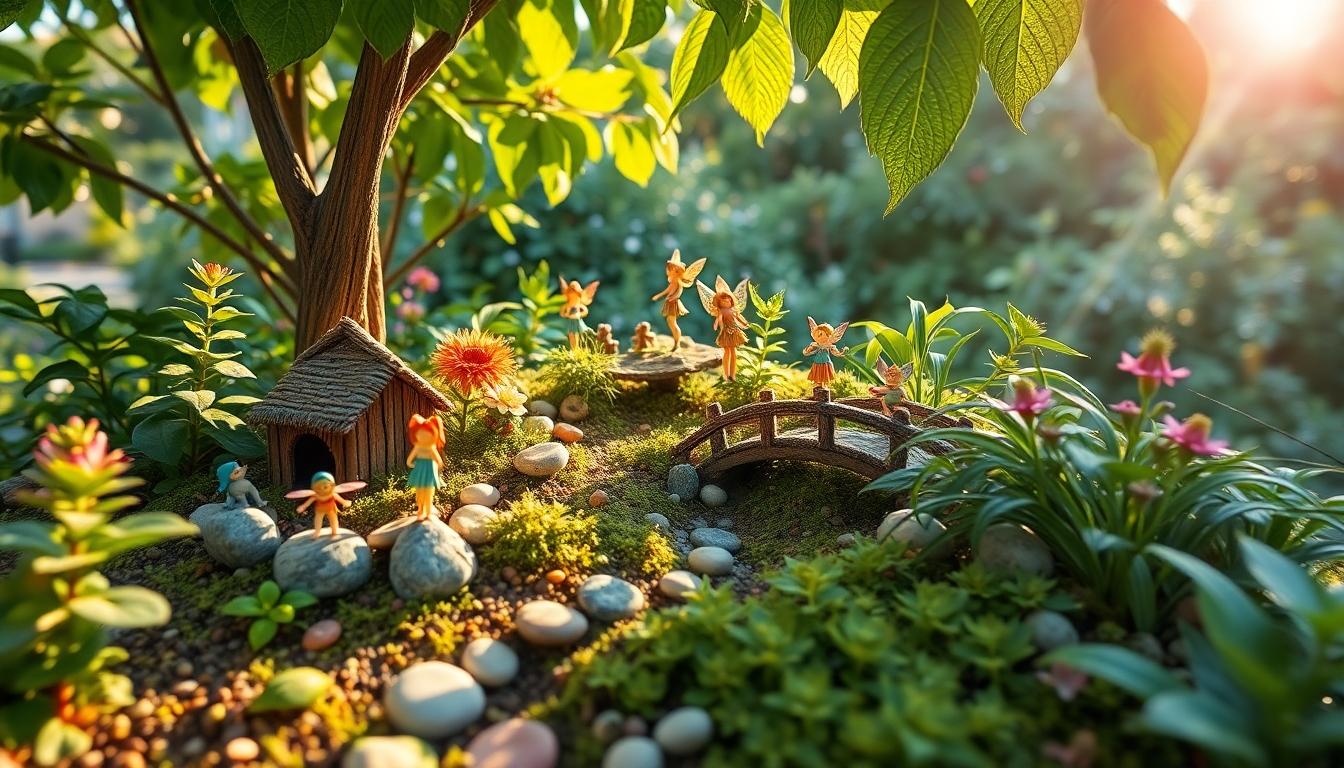
Keeping your fairy garden looking magical year-round requires exact care practices as seasons change. We’ve compiled essential maintenance tips to ensure your miniature wonderland thrives throughout the year.
Watering Practices
Regular watering forms the foundation of proper fairy garden maintenance. A drip irrigation system works best for delicate fairy gardens, preventing damage that can occur from heavy water flow. During summer months, you’ll need to increase watering frequency, while winter typically requires less frequent hydration. Always check soil moisture before watering by inserting your finger about an inch into the soil—if it feels dry, it’s time to water.
Fertilizing Techniques
Fairy gardens benefit from regular fertilization to keep plants healthy and vibrant. Choose between organic options like compost tea or diluted seaweed extract for a natural approach, or select chemical fertilizers specifically formulated for miniature plants. Apply fertilizer at half-strength to avoid overwhelming the delicate root systems of small plants. During active growing seasons (spring and summer), fertilize every 2-3 weeks, then reduce to monthly applications during fall and winter.
Pruning Methods
Maintain the miniature scale of your fairy garden through regular pruning. Trim overgrown plants promptly, especially during winter months when many plants become dormant and can be shaped more aggressively. Keep pathways clear by cutting back encroaching plants that might obscure your fairy accessories. Specialized small pruning scissors or bonsai tools work perfectly for precision trimming without disturbing the surrounding elements.
Pest Control Strategies
Monitor your fairy garden regularly for signs of pests like aphids, spider mites, or fungus gnats. Early intervention prevents widespread damage to your miniature industry. Natural remedies such as neem oil spray or insecticidal soap effectively control most common pests without harming your fairy garden inhabitants. For indoor fairy gardens, improve air circulation to discourage fungal issues that can develop in humid environments.
Protecting Your Fairy Garden During Harsh Weather
Extreme weather conditions require special protective measures for your fairy garden. Cover outdoor fairy gardens with frost cloth or bring container gardens indoors when temperatures drop below freezing to prevent damage to both plants and decorative elements. During heavy rainfall, ensure proper drainage by elevating containers slightly or adding drainage holes to prevent waterlogged soil that can rot roots. For scorching summer days, provide partial shade using miniature umbrellas or canopies that blend seamlessly into your fairy theme while protecting sensitive plants.
Refreshing and Updating Your Fairy Garden Design
Keep your fairy garden looking fresh by embracing seasonal theme updates throughout the year. Add miniature pumpkins and colored leaves in fall, snowflakes and evergreen elements in winter, and colorful blooms in spring to reflect the changing seasons. Rotate plants periodically to maintain visual interest and replace any that have outgrown the scale of your fairy garden. Renew soil annually by gently removing the top layer and adding fresh potting mix rich in nutrients to prevent soil compaction and nutrient depletion. This regular refreshment ensures your fairy garden remains an enchanting miniature industry regardless of the season.
Conclusion: Bringing Magic to Your Garden with Fairy Elements
Creating your own fairy garden isn’t just a decorative project—it’s an ongoing journey into a industry of imagination and creativity. Whether you’re crafting with children or designing an elaborate display for your home we hope these ideas have sparked your imagination.
The beauty of fairy gardening lies in its endless possibilities. From repurposed teacups to elaborate tree stump villages there’s a fairy garden style that fits every space and skill level. Remember that your miniature industry will evolve with the seasons bringing new charm throughout the year.
We’d love to see your magical creations! Share your fairy garden photos and join our community of enchantment enthusiasts. Your next magical masterpiece awaits—all it takes is a little creativity and a touch of fairy dust.
Frequently Asked Questions
What is a fairy garden?
A fairy garden is a miniature landscape that creates a whimsical, magical scene using small plants, tiny accessories, and fairy figurines. These enchanting gardens can be created in containers, garden corners, or even indoors, and serve as imaginative spaces that delight both children and adults alike.
What containers can I use for a fairy garden?
You can use almost any container for a fairy garden including flower pots, teacups, wooden boxes, bird baths, old wheelbarrows, or tree stumps. The best containers have adequate drainage and match your desired theme. Even broken or chipped items can be upcycled into charming fairy garden homes with a little creativity.
What plants work best in fairy gardens?
Choose small, slow-growing plants like miniature ferns, baby tears, Irish moss, woolly thyme, and small sedums. Miniature African violets and tiny succulents work well for indoor gardens. Select plants with similar light and water requirements, and consider dwarf varieties of your favorites to maintain the proper scale.
How do I create pathways in my fairy garden?
Create magical fairy garden pathways using small pebbles, crushed shells, miniature cobblestones, flat river rocks, or tree stump slices. Arrange them in winding patterns connecting different elements of your garden. For added charm, edge pathways with tiny plants or moss, and consider illuminating them with miniature fairy lights.
Can I add water features to a fairy garden?
Yes! Miniature ponds can be created using small plastic containers or jar lids sealed with waterproof material. For running water, use tiny pumps in larger gardens. Alternatively, create the illusion of water using blue glass pebbles or resin. Place water features in accessible locations for easy maintenance and maximum visual impact.
How can I create a fairy garden with children?
Start with a simple container and child-safe materials. Let younger children help with planting and placing decorations, while older kids can help design the layout. Collect natural materials together during outdoor walks, and incorporate their toy figurines. Focus on the process rather than perfection to make it a fun, educational experience.
How do I maintain my fairy garden?
Water carefully using spray bottles or small watering cans to avoid flooding. Feed plants with diluted liquid fertilizer during growing seasons. Regularly trim plants to maintain scale, remove wilted flowers, and check for pests. Protect outdoor fairy gardens during extreme weather with covers, and refresh decorations seasonally to maintain interest.
What are some seasonal fairy garden themes?
Spring gardens can feature pastel colors, miniature gardening tools, and flowering plants. Summer gardens might include beach themes with tiny umbrellas and seashells. Fall gardens can showcase miniature pumpkins and golden foliage, while winter wonderlands can include evergreens, miniature holiday decorations, and faux snow for a magical effect.
How do I choose fairy figurines and accessories?
Select weather-resistant resin or metal figurines for outdoor gardens and more delicate materials for indoor displays. Consider the scale—accessories should be proportionate to your container and plants. Handmade items add unique charm, while store-bought pieces offer consistency. Choose figurines that reflect your garden’s theme and your personal style.
What household items can I upcycle for fairy gardens?
Transform chipped teacups into fairy cottages, use bottle caps as tiny tables, turn tin cans into miniature planters, or repurpose old toys as garden features. Broken flower pots can become fairy cave dwellings, while wine corks make excellent fairy stools or bridges. These upcycled elements add character while reducing waste.

